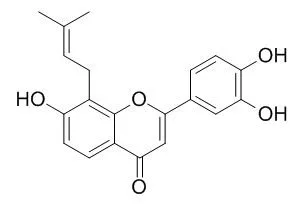Psoralea corylifolia is a plant widely used in traditional Chinese medicine, e.g. for its chemopreventive effect. To identify active substances responsible for this effect, we investigated pharmacological effects of 11 compounds isolated from the seeds of this plant (newly described substances: 7, 2', 4'-trihydroxy-3-arylcoumarin and psoracoumestan).
METHODS AND RESULTS:
The influence of distinct compounds on different signal transduction pathways (cell proliferation, survival, angiogenesis and metastasis) was screened via analysis of the activity of 24 protein kinases, mitogen activated protein kinase phosphorylation via Western blot, cytotoxicity was shown using the 3-(4,5-dimethylthiazol-2-yl)-2,5-diphenyltetrazolium bromide assay and determination of caspase activity. Oxidative stress was detected via 2',7'-dichlorofluorescein fluorescence.
Some compounds showed cytotoxic effects (H4IIE, Hct116, C6 cells) mainly mediated via induction of apoptosis. Distinct compounds caused a strong inhibition of MAPK/ERK kinase (MEK) phosphorylation, weak effects on extracellular-signal regulated kinase (ERK) phosphorylation and no significant effect on p38 and c-Jun amino-terminal kinase. Corylifol C and, to a lesser extent, xanthoangelol are potent protein kinase inhibitors (inhibitory concentration 50% values for epidermal growth factor receptor (EGFR): 1.1 and 4.4 × 10(-6) μg/ml, respectively). Because EGFR, MEK and ERK are kinases involved in cellular proliferation, an inhibition of these enzymes may be useful to cause chemopreventive effects.
CONCLUSIONS:
Distinct compounds isolated from P. corylifolia showed a high potential to influence cellular pathways, e.g. by inhibition of protein kinases that may be interesting for pharmacological purposes. |






 Cell. 2018 Jan 11;172(1-2):249-261.e12. doi: 10.1016/j.cell.2017.12.019.IF=36.216(2019)
Cell. 2018 Jan 11;172(1-2):249-261.e12. doi: 10.1016/j.cell.2017.12.019.IF=36.216(2019) Cell Metab. 2020 Mar 3;31(3):534-548.e5. doi: 10.1016/j.cmet.2020.01.002.IF=22.415(2019)
Cell Metab. 2020 Mar 3;31(3):534-548.e5. doi: 10.1016/j.cmet.2020.01.002.IF=22.415(2019) Mol Cell. 2017 Nov 16;68(4):673-685.e6. doi: 10.1016/j.molcel.2017.10.022.IF=14.548(2019)
Mol Cell. 2017 Nov 16;68(4):673-685.e6. doi: 10.1016/j.molcel.2017.10.022.IF=14.548(2019)